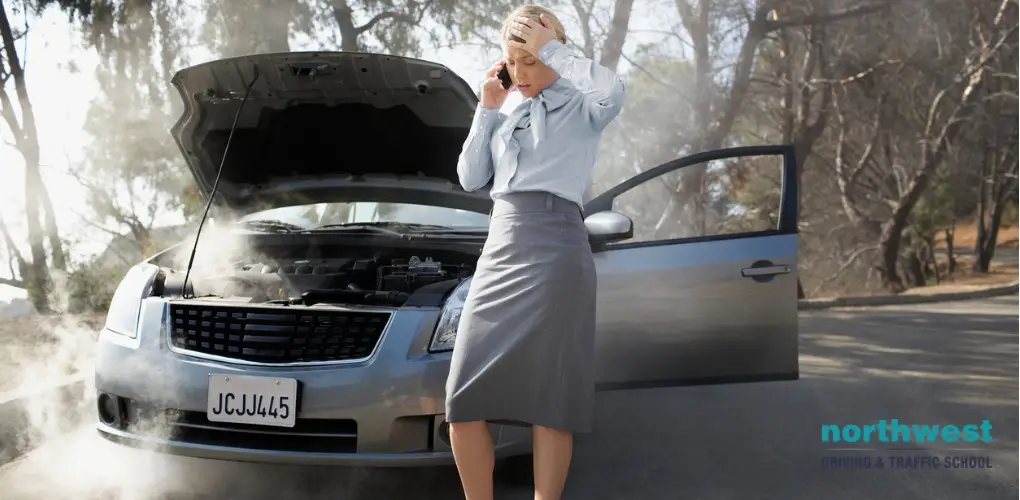- Driving School
What to do if Your Car Overheats?

Driving off into the sunset, you can feel the cool breeze wafting in through your car window. The world looks beautiful from behind that steering wheel, and nothing has ever felt more liberating. But what happens if all of a sudden, as soon as you hit 50 km on the highway, steam begins billowing out of your engine?
It’s understandable to panic, but learning how to solve this problem is extremely important for any learner driver who wants to be prepared for unexpected surprises on the road. This blog post will explore everything learners need about automotive overheating and provide them with step-by-step guidance on tackling it before it becomes too serious.
Table of Contents
- Identify the signs of your car overheating
- Open up the hood to allow air to circulate and cool down the engine
- Fill up your radiator with coolant if needed
- Call for roadside assistance and/or have your car towed to a mechanic if necessary
- Inspect your cooling system periodically to ensure it is working properly
- Keep cool and keep driving!
Identify the signs of your car overheating
Various signs indicate when your vehicle is overheating, and it’s essential to be aware of them to avoid any major damage to your car’s engine.
Low coolant levels are one of the most obvious signs of an overheating car. Pull over on the side of the road and turn off the engine as soon as possible. Coolant is responsible for regulating your engine’s temperature, so when it’s low, your car is more susceptible to overheating.
Another sign to look out for is steam rising from the hood of your car. The boiling coolant causes this steam, and it’s a clear indication that your engine is too hot.
Lastly, a warning light on the dashboard is one of the most reliable indicators of an overheating engine. If you spot any of these signs in your car, it’s crucial to pull over as soon as it’s safe and turn off the engine to prevent any further damage.
Open up the hood to allow air to circulate and cool down the engine
One simple solution to an overheated engine is to open up the hood and allow air to circulate and cool down the engine. By doing so, you’ll be helping your car stay at a safe operating temperature and prevent damage to your engine.
Taking just a minute to pop the hood could save you from a costly repair bill and keep you on the road during the year’s hottest days. So, the next time you’re driving and notice your car running a little hot, remember to pull over, open the hood,, and let your engine breathe.
Fill up your radiator with coolant if needed
Given the temperature of a Nevada summer, you should always keep an eye on your radiator’s coolant level. The coolant helps to regulate your car’s temperature, preventing your engine from overheating, which can cause severe damage.
If your car is low on coolant, filling it up as soon as possible is important to avoid any issues. To do this, locate your car’s radiator cap and add the coolant slowly until it reaches the appropriate level. Simple steps like this can help ensure your car runs smoothly for years.
Call for roadside assistance and/or have your car towed to a mechanic if necessary
If your car does overheat, it’s important to take action immediately to avoid causing any further damage to your vehicle. In this situation, it’s best to call for roadside assistance or have your car towed to a mechanic if necessary.
Attempting to fix the problem yourself can lead to costly mistakes and potential safety hazards. Don’t let an overheating engine put a damper on your day – reach out for help and get your car back on the road as soon as possible.
Inspect your cooling system periodically to ensure it is working properly
Your car’s cooling system is vital to keeping your engine running smoothly, but it’s often overlooked until a major problem arises. That’s why it’s important to inspect your cooling system periodically to ensure it’s working properly and catch any signs of potential issues before they become serious.
Overheating can lead to costly repairs and even engine failure, so don’t wait until it’s too late. Taking the time to inspect and maintain your cooling system can save you time, money, and a whole lot of headaches down the road.
So, be sure to keep an eye on your coolant levels, hoses, and fans, and address any potential problems as soon as they arise to keep your engine running cool and trouble-free.
Remember to always be prepared when you’re on the road, and take action as soon as you notice any of your car’s warning signs. Overheating can happen to anyone, even the most experienced drivers, so stay calm and follow these steps to get your car back on track.
Keep cool and keep driving!
It’s important to understand what can cause your car to overheat and how to respond if it happens. Identify the signs of your car overheating, such as low coolant levels, steam from the hood, or a warning light on the dashboard. Pull over and shut off your engine, open up the hood to allow air to enter and cool down the engine. If needed, put some coolant in the radiator.
Remember to call for roadside assistance or have your car towed to a mechanic if necessary. To avoid future issues with your cooling system, inspect it periodically and fix any possible problems before they worsen.
Northwest Driving School is here for all your driving needs – contact us today to book your driving lesson and ensure your safety while on the road. Keep cool, stay safe, and keep driving!
At Northwest, you can expect to find outstanding classes, both on campus and behind the wheel, that are engaging, fact-filled, entertaining, and geared toward success.

